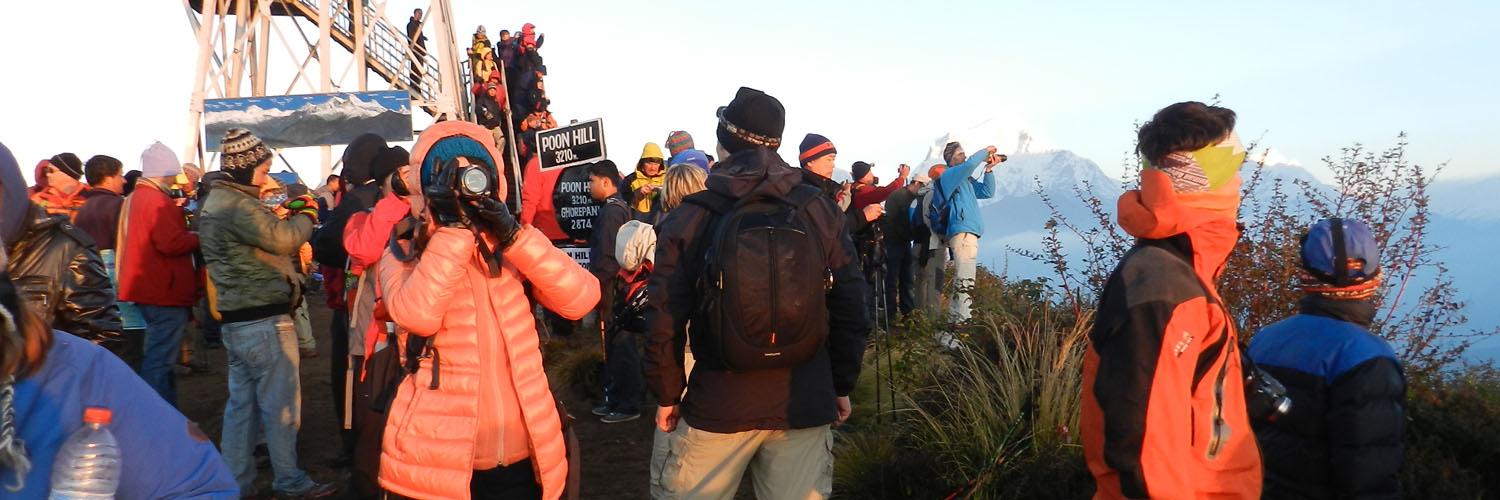The Ghorepani Poon Hill trek is the ultimate Himalayan experience, offering breathtaking panoramas, passing along traditional villages, and a taste of adventure without an extreme physical challenge. This trek is suitable for trekkers of all experience levels, making it a perfect choice for those seeking a moderate yet rewarding adventure in the Himalayas. The trek offers stunning views of the Annapurna and Dhaulagiri mountain ranges, beautiful rhododendron forests during the spring season, and beautiful villages. To make the most of your trekking experience, here are some important things you need to know before setting out.
Location: Annapurna Region, Nepal
Starting Point: Nayapul or Ghandruk
Ending Point: Nayapul or Ghandruk
Duration: 4-5 days
Maximum Altitude: Poon Hill (3,210 meters / 10,532 feet)
Difficulty: Moderate
Best Time: Spring (March to May) and Autumn (September to November)
Getting There
You need to get to Pokhara for the trek to Ghorepani Poon Hill. Pokhara can be reached from Kathmandu by flight in about 25-30 minutes. Alternatively, you can choose daily tourist buses that depart from Kathmandu’s tourist bus park to Pokhara. The journey takes around 6-8 hours. You can also hire a private car for a more comfortable and flexible journey from Kathmandu to Pokhara drive and vice-versa.
Accommodation
Accommodation during the trek will be at basic lodges known as ‘Tea-house’ that offer simple accommodation, meals, and basic amenities. They are a popular choice among trekkers as they are affordable and provide a cozy resting place after a long day of hiking. These tea houses are located along the trekking route, offering amenities such as hot showers, cozy and simple rooms, and central dining with food. Most teahouses offer twin-bedded rooms with basic furniture like beds, blankets, and pillows. It might be shared bathrooms with basic amenities like showers and toilets are the norm. Teahouses often have a communal dining area with a fireplace or wood-burning stove, offering a warm and inviting space to relax and socialize with fellow trekkers after a day on the trail.
Food & Meals
The Ghorepani Poon Hill trek might not have an elaborate menu as in the cities, but the food you'll encounter at teahouses along the way is delicious, hearty, and perfectly suited to fuel your adventure. Dal Bhat, the comforting combination of lentil soup (dal) with steamed rice (bhat) is a staple for both locals and trekkers. Besides Dal Bhat, teahouses offer a wider range of options to satisfy your appetite such as porridge, toast with eggs, pancakes for breakfast. For lunch or dinner, items like Dal Bhat, noodles, momos, pasta, pizza, soup can be choosen.
Weather
The best time to trek to Ghorepani and Poon Hill in the Annapurna region is during the spring
(March-May) and autumn (September-November) seasons. During this time, the weather is clear, with Annapurna and Dhaulagiri Mountains appearing with spectacular views. It’s the ideal time for hiking, with not much heat and minimal rainfall. You can observe a spectacular sunrise over the Himalayas.
Winter (December-February) while is not the most popular time but it can be a unique experience. The trail will be less crowded and generally mountains can be visible, and there will be chances of snowfall. The trails can be snowbound and nights will have a freezing temperature, so proper trek gear is essential.
June-August (Monsoon) is the least ideal time due to rain with muddy trails and the chances of landslides. The mountains are also obscured by the clouds.
Fitness level
The Ghorepani Poon Hill trek is considered to be a moderate trek, suitable for all levels of fitness. However, it does involve some steep uphill and downhill sections, so it is important to be physically prepared for the trek. The trails are well-maintained and don't require any technical climbing skills. The trek typically covers 45-56 kilometers (28-35 miles) round trip, with daily hikes ranging from 4 to 6 hours. The trek starts at a lower altitude and it gradually ascends to it's highest point, Poon Hill at 3,210 meters (10,530 feet). This can still pose a challenge for some trekkers due to thinner air and potential altitude sickness. You can go for regular cardio and strength training which significantly improve your endurance and make the hikes more manageable. There might be some steeper sections on the trail, but overall, the inclines are gradual.
Altitude sickness
The Ghorepani Poon Hill trek, while not reaching extreme altitudes, still carries a risk of altitude sickness. During hike to Poon Hill located at 3,210 meters, you need to take it slow, stay hydrated, and be aware if you start experiencing symptoms of altitude sickness. Make sure to drink plenty of water, eat well, and take regular breaks to allow your body to adjust to the altitude.
Packing list
Some essential items to pack for the trek include sturdy hiking boots, warm clothing, a good quality sleeping bag, sunscreen, a hat, sunglasses, a first aid kit, and plenty of snacks. It is also a good idea to carry some cash as there are no ATMs along the trekking route.
Trekking Permits
There are two permits for the Ghorepani Poon Hill trek which are the Annapurna Conservation Area Permit (ACAP) and the Trekkers' Information Management System (TIMS) card. These permits are handled by your trekking agency like Marron Treks and you don’t need to worry about it.
Tips for a Successful Trek
Start Early: Begin your days early to make the most of daylight and enjoy the morning views.
Remain Hydrated: To lower your risk of altitude sickness, drink lots of water and stay away from alcohol.
Respect Local Culture: Be conscious of local customs and traditions. “Namaste” is saying 'hello' and while taking photos, ask for permission.
Trekking to Ghorepani Poon Hill is the best moderate trek in the Himalayas that provides beautiful views of the mountains and an insight into traditional Nepalese culture.
With proper preparation and a sense of adventure, you are sure to have a memorable trekking experience in this beautiful region.
Author: Marron Treks
Date: 1st September, 2024


